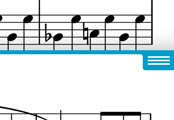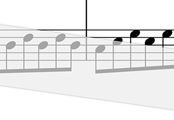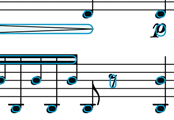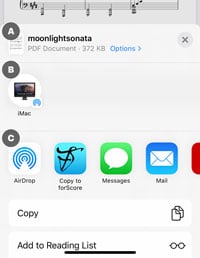Version 15.0.7
The current version of forScore is 15.0.7. If you're experiencing issues while using an older version, updating may help.Otherwise, the easiest way to fix intermittent issues is to quit and relaunch the app. Find out how here.
User Guides
For more in-depth information, check out our user guides.Additional Support
For personalized support, forScore Pro subscribers can contact us directly by opening forScore's Tools menu and choosing 'Support.'If you wish to submit feedback and do not need a response or if you have pre-purchase questions, click here to send us a message.
Please read our support policy here. We are generally unable to provide personalized support and replies are not guaranteed, especially for topics addressed on this page or in our user guide.
Sharing
Accessing the iTunes File Sharing panel
macOS 10.15 or later
With macOS 10.15, Apple restructured iTunes and split up its functionality into several different apps: Apple’s File Sharing panel can now be accessed directly through Finder.
Warning: Apple’s File Sharing panel in macOS 10.15 does not prompt you when you attempt to add a file with the same name as an existing file. Instead, it permanently overwrites the app’s copy with the computer’s copy and this cannot be undone. We do not recommend using Apple’s File Sharing panel at this time.
- Connect your iOS/iPadOS device to your computer
- Open a new Finder window on your computer and select your iOS/iPadOS device in the sidebar
- Select the “Files” tab
- Find forScore in the list of apps and click the arrow button just to the left of its icon to reveal its documents list
forScore Backup Utility (recommended)
As of October 2019, Apple’s file sharing interface within Finder lacks basic functionality like the ability to select multiple files, so we created our own version and built it into our free Mac app called forScore Backup Utility which includes all of the same features as Apple’s version and more. We strongly encourage users to take advantage of this app rather than use Apple’s incomplete interface.
- Download and launch forScore Backup utility on your Mac running macOS 10.14 or later
- Connect your iOS/iPadOS device to your computer
- Launch forScore (version 11.1 or later), tap to show the navigation bar if necessary
- Tap the toolbox icon in the top right-hand corner and choose “backup” from the list
- On your Mac, click the “File Sharing” button when it appears in the main window
Windows, macOS 10.14 or earlier
With macOS 10.14 or earlier, or with all versions of Windows, File Sharing is built into iTunes and the interface varies based on which version is currently installed. Use the instructions below that correspond to your version of iTunes to access the File Sharing panel and forScore’s documents.
iTunes 12.7 or later
- Connect your iOS/iPadOS device to your computer
- Open iTunes on your computer
- Click the small device icon in the upper left corner, next to the library drop-down menu
- Click the “File Sharing” item that appears in the left sidebar under Settings
- Choose forScore from the list of apps to see a panel on the right showing all of forScore’s documents
Sharing scores
Whether you want to share a file with a colleague, print out a score with all of your annotations, or send a copy to another app on your device, forScore’s Share function can help. To share one or more items, use any of the following methods:
- Choose the “Share” option in the tools menu or from the title bar’s popup menu to share the score you’re currently viewing.
- While viewing a list of scores or bookmarks in most of forScore’s menus, either swipe from right to left over an item and tap the Share action or tap and hold an item and choose “Share” from the popup menu.
- In the Scores or Bookmarks menus, or while viewing the contents of a setlist in the Setlists menu, tap the “Edit” button on the right-hand side of the navigation bar, tap to select one or more items, and choose the “Share” option at the top of the list.
Any of these actions will prompt you to share your item or items in a variety of formats with additional options where applicable. You can share a single file as an unmodified PDF file, a permanently annotated PDF file, or using a special forScore-only “4SC” file format that includes editable annotations, metadata, links, and more. If you’re sharing more than one file, you’ll see an additional text list option. Note that some of these formats may be unavailable depending on the content you’re sharing (e.g. password-protected files).
Tap a thumbnail icon to share using the default options or tap the ellipsis (…) button to adjust your sharing settings first. When sharing a single item as a PDF or annotated PDF, you can specify a range of pages to share instead of sharing the whole file. When sharing one or more files as an annotated PDF, you can choose to use forScore’s standardized aspect ratio or preserve the original file’s aspect ratio instead. When sharing multiple files as a text list, you can choose to include numbers, composers, and whether or not to sort the items alphabetically.
When you’re finished, a new popup will appear giving you a wide range of sharing options. This popup, called a “share sheet,” is provided by the system and its contents depend on your device’s setup and which apps you currently have installed. Common options include Mail, Messages, Print, and—if your device supports it—AirDrop (which lets you share files quickly with other iOS users in close proximity). You will also have the option to copy your file to any other PDF-compatible apps on your device, like iBooks or Dropbox.
In-Place Editing
As of forScore 10.4, sharing certain files with other apps may either send a new copy of the file to that app, or it may make forScore’s copy available for in-place editing (if the target app supports this). Changes made to your files in this manner are immediately reflected within your forScore library. In-place editing is not supported when sharing modified files, such as annotated PDFs or 4SC files.
Using cloud services
Use online storage services to store and access any scores you don’t have room for on your device, to share music with friends and colleagues, or to manually back up your most important files. While we provide access to some third-party services through our app, we have no control over their service or terms and conditions, both of which are subject to change at any time. Please be sure to visit their respective websites if you have any questions prior to signing up for or using these services.
Files, iCloud Drive, and File Providers (preferred)
With iOS 11, Apple introduced the Files app and interface which gives you system-wide access to your documents whether they’re stored on your device, in iCloud Drive, or elsewhere. Many third party apps and services choose to make their content available through this interface (called “File Providers”). You continue to use the same interface you’re used to within the Files app, but behind the scenes that third-party app is doing the work of updating and maintaining your documents wherever they’re stored. Major cloud services such as Dropbox, Google Drive, Box, Microsoft OneDrive, SugarSync, and Amazon Drive have all updated their apps to work this way, and other apps such as FileExplorer and FileBrowser let you configure and connect to many different locations including servers that use FTP, SFTP, or WebDAV.
Visit this page to learn more about working with the Files app and interface.
The Services Panel
Getting Started
forScore’s Services panel also allows you to access and work with files stored in your Dropbox or Box account. Tap the + button to pick which services you use. When you’re done, select any of your preferred services from the account list to log in and begin using it. Services ask you to log in as you start using them, or if your credentials expire.
Once you’ve successfully logged in, you’ll be able to navigate through your folders and see your files. You can upload, download, move, and delete many of the file types forScore supports, including PDF files, forScore-specific (4SC, 4SS, and 4SB) files, comma-separated (CSV) files, and many audio file formats. You can also download some kinds of text files (TXT, RTF, DOC, and DOCX) and they’ll be automatically converted to PDFs once they’ve been downloaded. Unsupported or unrecognized file types are greyed out.
Downloading Files
Tap on a file to download it and a copy will be saved into your forScore library. If a file with the same name already exists in your library, you’ll be asked to duplicate or overwrite the file, or to cancel the transfer. Tap the stop button in the middle of the progress wheel to cancel a file transfer.
To download all files within a folder:
- View the folder you’d like to download from
- Tap the Edit button in the upper right corner of the panel
- Tap the “select all” button along the bottom of the panel (a circled check mark)
- Tap the “download” button (cloud with an arrow pointing down out of it) to start downloading the selected files
If you have setlists in your current forScore library, you can also download one or more scores and add them to a specific setlist automatically once they’re finished. Swipe from right to left over a single score and choose “Download…” to see a list of options: download the item normally, download it to the last setlist you were viewing in the Setlists menu, or choose any setlist from a complete list. To download multiple files into a setlist, tap the Edit button, select your files, and tap the download icon at the bottom of the panel—the rest of the process is the same.
Moving Files
While in edit mode, tap to select one or more files, then choose “Move” from the control bar. The selected files will turn blue, and you’ll be able to select directories or use the back button to navigate to the desired destination. When you’re ready, tap the “Move” button once again to send the selected files to the current directory.
Uploading Files
To upload files, tap the + button at the bottom of the panel. This presents a searchable list of all the files in your library that can be uploaded, with separate tabs for scores, setlists, audio files, backups, and other file types such as CSV indexes. Depending on which tab you’ve selected, you may also see additional upload options in the bottom right-hand corner of the upload picker. When viewing scores, for instance, you can choose to upload the original PDF file as-is, a forscore-specific (4SC) file that includes editable annotations and additional information, or as a flattened PDF file with non-editable annotations. Tap one or more files to select them, then tap the “Upload” button in the upper right corner of the menu to begin the upload process. If you would like to select all files, tap the All button at the bottom of the panel.
Drag and Drop
If you’re using iOS 11, you can also use Drag and Drop gestures to upload items or move files between folders:
To move files, tap and hold your finger over any supported file until it animates up and then drag your finger away to begin. While continuing to drag the first file, tap additional items to collect them, if desired, then drop them onto a folder to move them there or use your other fingers to navigate into and out of folders as needed until you’re viewing the target location, then drop the files to finish moving them.
To upload, drag one or more scores, setlists, or other supported files from forScore’s various menus into the Services panel and drop them into the list to upload them there or use your other fingers to navigate to the correct location first. If necessary, you’ll be asked to choose which format you want to use once you drop your files into the Services panel.
Does forScore sync content across devices?
Yes, forScore can use your iCloud account to keep your content up to date across all of your devices automatically. It was initially offered in forScore 12.1 on a limited basis, and was made available to all users with forScore 13.0. Visit this page to learn more about syncing, accounts, storage quotas, and backups.
If needed, you can also manually copy your entire library from one device to another (without using iCloud Syncing) by following the instructions on this page: Transferring your forScore library to another device
Adding/prioritizing forScore in iOS’s sharing options
Apple’s sharing interface changed starting in iOS 13 and iPadOS 13, and forScore may not appear where you expect. This “share sheet,” as Apple calls it, can be customized so you can add forScore to the visible choices and even prioritize it over other apps. To begin, open a PDF file in a compatible app and share it (for instance, navigate to a PDF file in Safari and then tap the action icon—it’s a square with an arrow pointing up out of the top).
The new share sheet shows a thumbnail preview of your PDF file (labeled “A” in the image on the right) and some basic file information at the top, with an “x” button on the right to close the sheet if you want to cancel sharing. Below that row, you may see a row of sharing shortcuts (“B”) that let you do things like AirDrop a file to your computer, send a file to a recent or favorite contact via Mail or Messages. Note: this section does not always appear.
Further down in the Share Sheet (labeled “C” in the image on the right), you’ll see the AirDrop icon and a horizontally scrolling list of compatible Apps you can share the file with. The apps that appear here and the order in which they appear is determined by the system and may change over time, but you can specify which apps you prefer and prioritize them so that you can always find them quickly. To do so, scroll all the way to the end of this row where you’ll find a “more” item. Tap it to see all of the available options, and tap “Edit” in the top right-hand corner of the panel to adjust them.
The upper section contains your favorites—tap the red circle to the left of an item to remove it or drag the three horizontal lines on the right up and down to prioritize the apps you use the most. If an app isn’t shown in the Favorites list, scroll down to the Suggestions section and find it there (tap the green “+” button to move any of them up into the Favorites list). If an app does not appear in either of these sections, you may not be sharing a file type that the app understands.
Keep in mind that this interface is provided by Apple and we have no control over it whatsoever. Aside from declaring our app as compatible with certain file types like PDFs, audio files, or CSV indexes, there’s nothing else we can do to make forScore available within it or choose where it appears. This interface may change over time and we cannot provide step-by-step instructions for every version of iOS or iPadOS. The general principles should help guide you, but may not apply literally in all cases.
Working with the Files app in iOS 11 or later
 iOS 11 introduced the Files app (formerly called the iCloud Drive app) which gives you access to many of your documents across your device, apps, and cloud storage services. It’s a centralized way to work with files and manage or share them no matter where they come from, and when used with iOS 11’s Drag and Drop gestures it becomes an even more powerful tool that can be used in a variety of helpful ways.
iOS 11 introduced the Files app (formerly called the iCloud Drive app) which gives you access to many of your documents across your device, apps, and cloud storage services. It’s a centralized way to work with files and manage or share them no matter where they come from, and when used with iOS 11’s Drag and Drop gestures it becomes an even more powerful tool that can be used in a variety of helpful ways.
This knowledge base article provides an overview of the Files app and how it works in conjunction with forScore. For more information on using the Files interface as a modern replacement for forScore’s Services panel, see this page.
Working with Files
The Files app’s sidebar lets you browse by location or tags and gives you easy access your favorite folders. Tap any of the items in these lists to see the files within (or associated with) it. You can sort these files by name, date, size, and tags, switch between a list or grid view, and tap an item to preview it if supported. Tap and hold any item to see more options, allowing you to do things like rename, share, move, or delete a file. The “Select” button in the top right-hand corner lets you select one or more files and work with them simultaneously.
Copying from Files to other Apps
To send a copy of one of your files to an app like forScore, tap and hold the file (if you’re viewing the grid or list view) and choose “Share” or tap the item to open a full-screen preview and use the share icon in the top right-hand corner. More information on sharing files between apps can be found here. forScore works with PDF files, many audio formats, CSV files, and its own custom formats (4SC scores, 4SS setlists, and 4SB backups). forScore can also import certain types of text file and automatically converts them to PDFs upon import.
Copying from forScore to Files
forScore provides sharing features in a variety of different locations and contexts. Within most of forScore’s menus you can share a score, bookmark, or setlist by swiping over it from right to left and tapping “Share” or you can use edit mode to select and share multiple items. You can also swipe to share certain items when shown in the Search panel, backups panel, audio picker, and many of forScore’s other views. Tap the “Save to Files” option within the sharing interface to pick a location and save a copy of your content.
forScore’s DocumentsforScore 10.4
In the Locations section of the Files app’s sidebar, under “On My iPad” or “On My iPhone,” you can access the Documents directory of certain apps that store their content on-device, such as forScore. Working with forScore’s documents through the Files app has similar implications as using Apple’s File Sharing panel does: adding and removing files in this directory adds or removes them from your forScore library, and renaming PDF files is discouraged as it can lead to a loss of metadata, annotations, and other forScore information about that file. The use of subdirectories is not supported at this time.
When opening files from this directory in other apps, or when sharing them from within forScore 10.4 or later, those apps may offer in-place editing capabilities that permanently modify your content. Changes made to forScore’s files in this manner are reflected within forScore. Learn more about in-place editing by visiting this page.
Drag and Drop
When you’re using an iPad, Drag and Drop gestures allow you to work with content between apps, not just within them. That means you can drag scores, setlists, backups, and other kinds of content out of forScore and right into the Files app to copy them there. Or, drag compatible files from the Files app into various views within forScore to copy them the other way. Our importing and sharing articles provide more details about this.
File Providers
The Files app isn’t just limited to what’s on your device or stored in iCloud, any app can make its files available to the system interactively. You continue to use the Files app with its familiar interface and work just like you always do, but behind the scenes that third-party app is doing the work of updating and maintaining your documents wherever they’re stored. Common examples of third-party apps that take advantage of this system include Dropbox, Google Drive, Box, Microsoft OneDrive, Amazon Drive, SugarSync, and more.
If you’ve downloaded an app that has been updated to work this way, it will be available as an option in the Files app’s “locations” list but will be disabled by default. Tap “Edit” in the sidebar to see all available providers and flip the switch next to the ones you want to use to enable them.
Some apps provide access to multiple services or network locations by leveraging a variety of protocols, including FTP, SFTP, WebDAV, and more. Apps like FileExplorer and FileBrowser let you configure and connect to many different accounts, either through the Files app or using their own interface.
The Files Interface
Apple provides the standalone Files app to users, but it also makes the Files interface available to third-party apps like forScore so you can more easily manage your documents without constantly switching between apps. Visit this page to learn more about using the Files interface within forScore.
Opening and Editing Files In-Place
With iOS 11 and forScore 10.4 or later, the contents of forScore’s documents directory are now available through the Files app and you can view or edit them directly through other apps on your device. If you share files from forScore to other apps, it’s important to understand what features they offer and whether you may be permanently altering your files. Visit this page to learn more about in-place editing.
Dual Page mode with the Cue app
When using Dual Page mode with forScore 12.0.4 or later, pages sent to the Cue app use either Standard or Best Fit display mode (depending on your current forScore settings). Due to the way aspect ratio is handled, this can cause certain landscape-oriented pages to appear smaller than normal when you’re using Standard display mode. Switching to Best Fit mode ensures that you’ll see similar results as before; learn more about display modes and how to switch between them on this page.
Note: we highly recommend using Best Fit display mode in general, even when not using Dual Page mode. It’s currently the default display mode for new users and will become the default choice for all users in the future.



